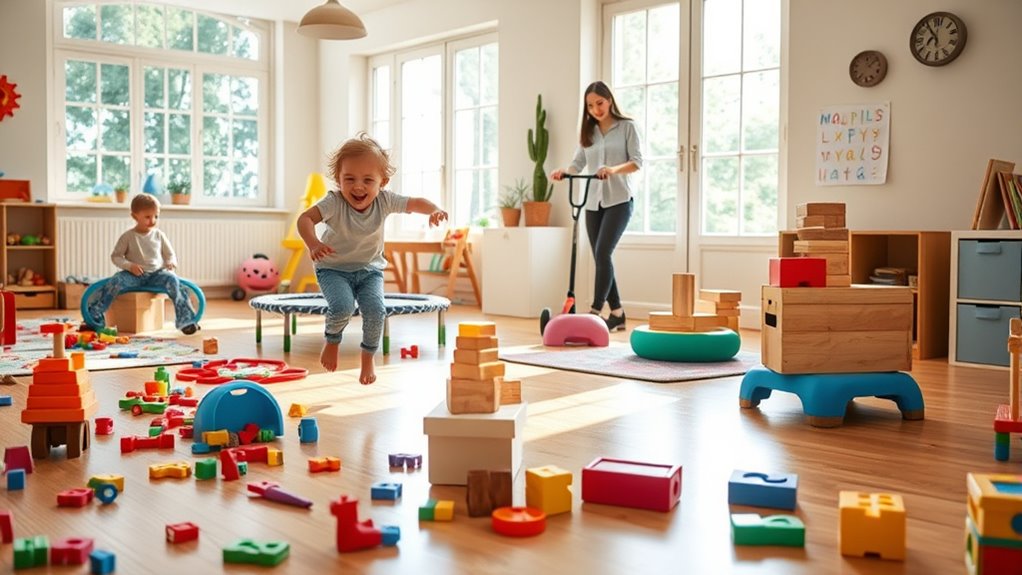To build an effective daily play rhythm, start by creating predictable routines that naturally include play, like quick interactions during mornings or chores turned into fun challenges. Set specific times for focused play, using cues like songs or special toys, so your child knows what to expect. Embed playful moments into everyday tasks to make play seamless and enjoyable. Keep consistency in your routine, and you’ll find it easier to maintain. If you keep going, you’ll discover how to make play a joyful part of every day.
Key Takeaways
- Establish consistent daily times for play, such as after school or before bedtime, to create predictability and routine.
- Incorporate play into routine activities like breakfast, chores, or travel to seamlessly embed play throughout the day.
- Use cues like special toys or songs to signal transition into designated play times, reinforcing routine expectations.
- Turn everyday chores into playful challenges to make routine tasks engaging and foster spontaneous play opportunities.
- Maintain flexibility within routines to adapt to daily changes, ensuring play remains an enjoyable, sustainable part of life.

Creating a daily play rhythm that sticks can feel challenging, especially when life gets busy. You might find yourself juggling work, household chores, and other responsibilities, leaving little room for spontaneous play. Yet, establishing a consistent routine is key to making play a natural part of your child’s day. The secret lies in developing playful routines integrated into your daily habits, turning play into something that happens effortlessly rather than something you have to force. Instead of viewing playtime as an extra task, think of it as an essential thread woven into your everyday life. This approach helps both you and your child see play as a regular, enjoyable activity rather than an occasional luxury.
Start by identifying small pockets of time that naturally fit into your day. For example, during morning routines, you can incorporate quick, playful interactions—snuggling during breakfast, singing songs while brushing teeth, or playful chatter on your way to school or work. These moments set a lively tone and reinforce the idea that play is part of daily life. Similarly, routine activities like tidying up or preparing dinner can become opportunities for playful habits. Turn cleaning into a game—see who can pick up the most toys in a set amount of time—or add fun challenges to everyday tasks. This way, play doesn’t feel like an interruption but a natural part of daily habits.
Consistency is essential. When you create a predictable structure with playful routines, your child learns what to expect, which cultivates a sense of security and anticipation. For instance, setting aside a specific time each day—like after school or before bedtime—for focused play ensures it becomes a non-negotiable part of the day. Use cues to signal these routines, such as a special toy or a particular song, so your child begins to associate those cues with play. Additionally, understanding the importance of structured routines helps in establishing a sustainable play rhythm that benefits both parent and child, making it easier to maintain even during hectic days. Over time, these routines become ingrained, making it easier for you to maintain a play rhythm even during hectic days.
Frequently Asked Questions
How Do I Adapt My Play Rhythm During Busy Periods?
When busy, you should adopt flexible scheduling to fit play into your day. Prioritize essential activities and temporarily scale back less important ones. Adjust your play rhythm by carving out short, focused play sessions instead of longer ones. This way, you stay consistent without feeling overwhelmed. Remember, it’s okay to shift your play time around; maintaining a balance helps you stay engaged and refreshed, even during hectic periods.
What Tools Can Help Track My Daily Play Schedule?
Think of play tracking tools as your personal GPS for fun, guiding your daily play schedule with precision. Apps like Toggl Track or RescueTime help monitor your activities, giving you clear visuals of when you’re playing and when you’re not. They make schedule management effortless, showing you where to adjust your pace. With these tools, you stay on course, ensuring your play rhythm flows smoothly, even on busy days.
How Can I Maintain Motivation to Stick to My Rhythm?
You can stay motivated by using motivational strategies like setting small, achievable goals and rewarding yourself for sticking to your rhythm. Reinforce the habit by tracking your progress and celebrating milestones, which keeps your focus positive. Remind yourself of why you started and visualize the benefits. Consistent routine and positive reinforcement make it easier to maintain your rhythm, turning it into a natural, enjoyable part of your daily life.
What Are Common Mistakes to Avoid When Building a Play Routine?
Like a captain steering through choppy waters, avoid common mistakes when building your play routine. Focus on playtime consistency to keep your ship on course, and steer clear of overcommitment that can cause the ship to list. Don’t let the routine become a rigid map—allow flexibility. Overloading your schedule with too much play or neglecting rest can sink your efforts, so balance fun with mindful boundaries.
How Do I Balance Play With Other Daily Responsibilities?
You can balance play with other responsibilities by prioritizing work-life balance and practicing effective time management. Schedule specific playtimes just like work tasks, so they don’t get overlooked. Use a calendar or planner to allocate slots for both work and play, and adhere to them. This approach ensures you enjoy quality play without sacrificing your daily responsibilities, keeping your routine balanced and fulfilling.
Conclusion
So, congratulations—your perfect daily play rhythm is finally in place. Who knew that balancing work, play, and rest could be so effortless? Just remember, the real trick is that there’s no trick. Sometimes, the best rhythm comes from embracing the chaos and rolling with the punches. So go ahead, enjoy your new routine, and watch how effortlessly life feels a little more playful—because, after all, the secret’s in not taking it too seriously.










